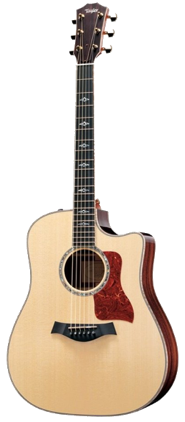get started. get better.

You love everything about guitar. Nothing sounds like it, and you can't go a few days without just having to play something. You've saved your money, and you're almost ready to pull the trigger and upgrade to a great guitar. But what should you look for?
In the last post, I talked about Taylor, Martin, and Gibson guitars along with the less-known, but amazing Olson guitar. The take-home is to keep in mind that with expensive guitars, there's more to it than just sound. I've put together some info that should help you pick out your "baby."
Brand
People love certain brands for a reason. Many brands have built a reputation from their products and have geared their product to a certain type of guitar player. The rule of thumb is that Martins are more for bluegrass (flat picking etc) and Taylors are more for rhythm. Gibsons have a pretty big, round sound while sounding a little tinny plugged in. These are pretty big generalizations but should help start your search.
Shape
Now we're on to one of the most misunderstood parts about picking out a nice guitar. The shape has a lot to do with the sound of the guitar as well as the style of guitar you intend to play. The standard acoustic guitar shape is called "dreadnought." This is your safest bet and is the perfect shape for mainly rhythm and some soloing. There are smaller guitars called "grand auditoriums" that are mainly for finger picking styles. Of course they will work if you strum, but the sound is more muted and a bit thinner.
I've seen a lot of people fall in love with the look of this type of guitar and overlook the sound of it. There's no "right and wrong" here, but be aware of the trade-offs, especially if you mainly plan to strum. By the way, in the Taylor world, most models end in two digits that tell you about the guitar shape. A "10" is a dreadnought" and a "14" is a grand auditorium. So a 614, for instance, is a grand auditorium shape. The jumbo is a guitar that has a large body and a very full sound with a lot of bass. They usually sound great and full even unplugged. So why doesn't everyone use them? Well, they kind of look funny for one. Also, lots of rhythm players just want to add a higher sounding consistent tone and don't want a really full, potentially overpowering sound. I've actually owned a mini-jumbo guitar that had an extremely limited run since it was just kind of awkward. It had a large bottom and a smaller top. As you are experimenting with shapes, listen for how the shape determines the lows mids and highs.
Tone Woods
When you look at high-end guitars, you won't have to worry too much about the quality of the wood, but you will need to be aware of the sound you'll get from the different woods. Typically you'll have different kinds of wood for the top versus the back and sides. Spruce is a very common top wood. You'll usually see Sitka spruce (better for harder strumming and brighter sounds) or the more expensive Englemann (better for milder playing and more overtones). You may run across cedar (less powerful sound), koa (hawaiian wood), and mahagony (good for blues and country)
As far as back and sides, rosewood is a great choice. Indian rosewood is a little more common, and Brazilian rosewood is the cream of the crop. There is an international trade embargo on this wood, so you'll only see it on limited guitars. Mahogony and Koa woods can also be used but have less low-end sound. Some may think that they sound a little more "natural." Fretboards have a less significant effect on tone, but many players are picky about which wood is used. You might see rosewoods and ebony used.
Electronics
To transfer all of that tone to a sound system, you'll need some good electronics. Fishman is probably at the top of the list here and L.R. Baggs is also well-known brand. Many of these onboard systems will have EQs built right in, and some, such as the expression pickups found on newer Taylors have only some basic controls. You normally either love or hate the expression pickup system. I'm personally not a fan of it. Also note that some guitars sound great plugged in and flat acoustically. Consider how much you'll be playing plugged in verses unplugged.
Frills
Now on to the stuff you don't need. Guitars can have bling too, and it normally comes in the form of design. Instead of normal position markers, you can get all sorts of extravagant inlay, you can get gold plated tuners, and there are even more frills with special/limited edition guitars. All of this, of course, only falls into the "I want that" category and doesn't really shape the sound or function of a guitar. It also dramatically increases the price.
The best advice I can give you is to try out as many guitars as you can, and find the perfect combination for your budget, your playing style (which will help determine your shape), electronics, and frills (if any). Also remember every guitar is a little bit different. When you find one that you just can't put down and would be devastated for weeks if someone else came behind you and bought it, you've found her!
Stephen